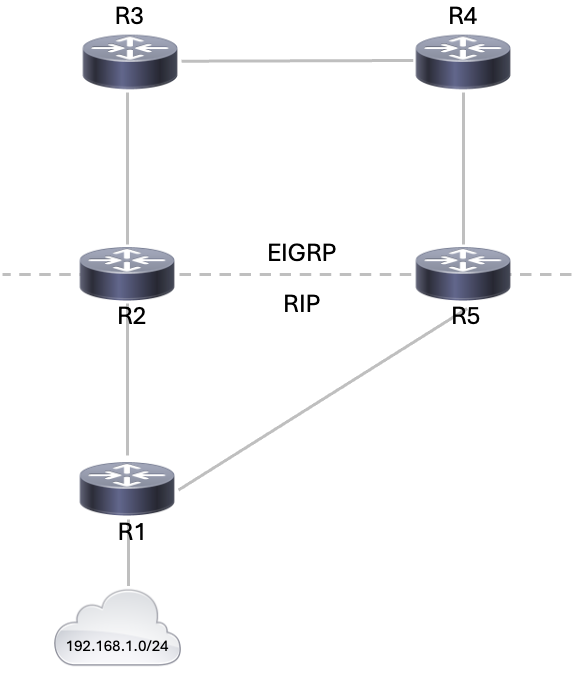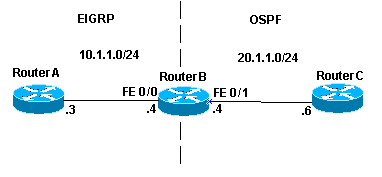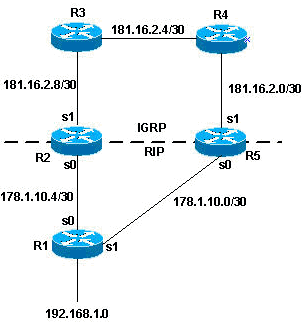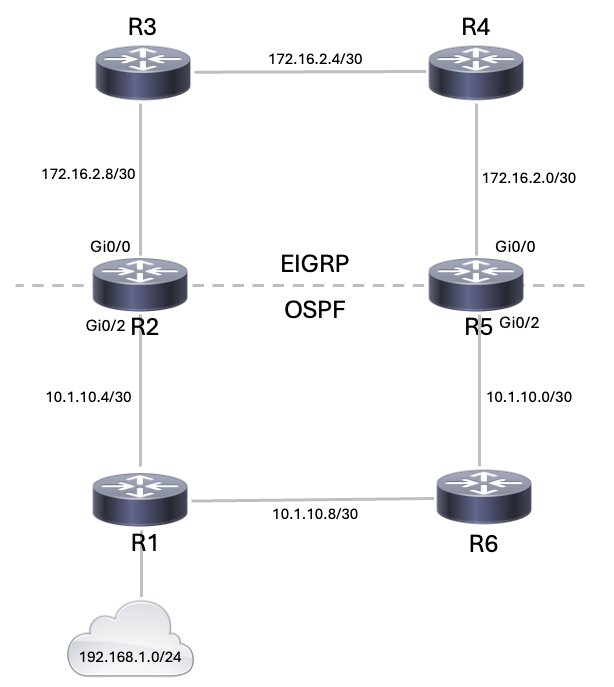配置路由协议重分发
下载选项
非歧视性语言
此产品的文档集力求使用非歧视性语言。在本文档集中,非歧视性语言是指不隐含针对年龄、残障、性别、种族身份、族群身份、性取向、社会经济地位和交叉性的歧视的语言。由于产品软件的用户界面中使用的硬编码语言、基于 RFP 文档使用的语言或引用的第三方产品使用的语言,文档中可能无法确保完全使用非歧视性语言。 深入了解思科如何使用包容性语言。
关于此翻译
思科采用人工翻译与机器翻译相结合的方式将此文档翻译成不同语言,希望全球的用户都能通过各自的语言得到支持性的内容。 请注意:即使是最好的机器翻译,其准确度也不及专业翻译人员的水平。 Cisco Systems, Inc. 对于翻译的准确性不承担任何责任,并建议您总是参考英文原始文档(已提供链接)。
目录
简介
本文档介绍如何将路由协议(直连路由或静态路由)重新分发到另一个动态路由协议中。
先决条件
要求
本文档没有任何特定的要求。
使用的组件
本文档中的信息不限于任何特定的软件和硬件版本
本文档中的信息都是基于特定实验室环境中的设备编写的。本文档中使用的所有设备最初均采用原始(默认)配置。如果您的网络处于活动状态,请确保您了解所有命令的潜在影响。
规则
有关文档规则的详细信息,请参阅 Cisco 技术提示规则。
背景信息
路由协议重分发是计算机网络中的一个重要概念,它支持不同路由域之间的通信。在企业和服务提供商网络中,通常针对特定使用案例部署多种路由协议,如开放最短路径优先(OSPF)、增强型内部网关路由协议(EIGRP)、边界网关协议(BGP)和路由信息协议(RIP)。重分发允许这些协议共享路由信息,从而确保不同网段之间的连接。
为什么需要重分发
- 多协议环境:组织可以出于各种目的部署不同的协议,例如BGP用于Internet路由,OSPF用于内部网络。
- 合并和收购:在集成过程中,具有不同协议的网络需要互操作。
- 可扩展性和优化:重分发可实现选择性路由共享,从而优化性能并控制路由行为。
再分配挑战
- 路由环路:配置错误可能会导致环路,降低网络性能。
- 管理距离和度量:每个协议都有独特的标准和优先级,在重分发过程中需要仔细了解。
- 路由过滤和安全:未过滤的重新分发可能会无意中传播不正确或不需要的路由。
对路由协议重分布的有效配置可确保网络间的无缝通信,最大限度地减少停机时间,并防止出现路由问题。通过使用过滤和环路预防等最佳实践,网络管理员可以实现稳健而高效的路由基础设施。
指标
当您将一个协议再分配到另一个时,切记每个协议权值在再分配中都扮演很重要的角色。每个协议都使用不同的度量。例如,RIP度量基于跳数,而EIGRP使用基于带宽、延迟、可靠性、负载和最大传输单位(MTU)的复合度量,其中带宽和延迟是默认情况下使用的唯一参数。在重新分发路由时,必须为接收路由定义一个可以理解的协议度量。重新分发路由有两种定义度量的方法。
 EIGRP和RIP拓扑
EIGRP和RIP拓扑
1. 您可以仅为该特定的重新分发定义度量:
router rip redistribute static metric 1 redistribute ospf 1 metric 1
2. 您可以将同一度量作为所有重新分发的默认值(使用 default-metric 命令,无需为每次重新分发单独定义度量,因此可节省工作量):
router rip redistribute static redistribute ospf 1 default-metric 1
管理距离
如果一个路由器运行多个路由协议,并通过两种路由协议获知通向同一目的地的路由,那么必须选择哪条作为最佳路由呢?每个协议都使用自己的度量类型来确定最佳路由。我们无法使用不同的度量类型来比较路由。使用管理距离可以解决此问题。将管理距离分配给路由源,便可以选择首选源的路由作为最佳路径。有关管理距离和路由选择的更多信息,请参阅 Cisco 路由器的路由选择。
管理距离有助于在不同路由协议中选择路由,但它们可能引起重分配问题。这些问题可能体现为路由环路、收敛问题或低效率路由。请参见下面显示的拓扑图和隐患说明。
 存在隐患的拓扑
存在隐患的拓扑
在上一个拓扑示例中,如果R1运行RIP,并且R2和R5都运行RIP和EIGRP并将RIP重分布到EIGRP中,则可能存在问题。例如,R2 和 R5 均通过 RIP 从 R1 获知网络 192.168.1.0。此知识将重分发到EIGRP。 R2通过R3获知网络192.168.1.0,R5通过EIGRP从R4获知该网络。EIGRP的管理距离比RIP低(90比120);因此,路由表中使用的是EIGRP路由。在这种情况下,可能会产生一个路由环路。即使使用了水平分割或任何其他有助于防止路由环路的功能,仍然存在收敛问题。
如果R2和R5也将EIGRP重分发到RIP(这是相互重分发),并且网络192.168.1.0没有直接连接到R1(R1从它上游的另一台路由器获知),则可能存在问题,即R1从R2或R5获知网络的度量可能比从原始源获得的要好。
注意:路由再分配机制是 Cisco 路由器的专有特性。Cisco 路由器上的再分配规则指明:被重新分配的路由显示在路由表中。路由存在于路由拓扑或数据库中的条件并不充足。路由表中往往会安装管理距离 (AD) 较小的路由。例如,如果静态路由在R5上重分发到EIGRP,然后EIGRP随后重分发到同一路由器(R5)上的RIP,则静态路由不会重分发到RIP,因为它从未进入EIGRP路由表。这是因为静态路由的AD为1,而EIGRP路由的AD为90,并且静态路由已安装到路由表中。要在R5上将静态路由重分布到EIGRP中,您需要在router rip命令下使用redistribute static命令。
有关详细信息,请参阅本文档的“避免因重新分发导致问题”部分。
重分发配置示例
EIGRP
此输出显示重新分发静态、开放最短路径优先(OSPF)、RIP和中间系统到中间系统(IS-IS)路由的EIGRP路由器。
router eigrp 1 network 10.10.108.0 redistribute static redistribute ospf 1 redistribute rip redistribute isis default-metric 10000 100 255 1 1500
EIGRP在重新分发其他协议时需要五个度量:分别是带宽、延迟、可靠性、负载和 MTU。
| 度量 |
价值 |
| 带宽 |
单位为千位每秒;以太网为 10000. |
| 延迟 |
单位为十微秒;对于以太网,该值为 100 x 10 微秒 = 1 毫秒 |
| 可靠性 |
255 对应于 100% 可靠性 |
| 负载 |
链路上的有效负载以0到255之间的数字表示(255是100%负载)。 |
| MTU |
路径的最小 MTU;通常与以太网接口相等,即 1500 字节. |
多个EIGRP进程可以在同一台路由器上运行,并在它们之间进行重分发。例如,EIGRP1和EIGRP2可以在同一台路由器上运行。但是,您不需要在同一路由器上运行相同协议的两个进程,这会占用路由器内存和CPU。将EIGRP重分配到另一个EIGRP进程不需要任何度量转换,因此不需要定义度量或将default-metric命令与重分配一起使用。
重分发的静态路由优先于汇总路由,因为静态路由的管理距离为1,而EIGRP汇总路由的管理距离为5。当在EIGRP进程下使用命令重分发静态路由且EIGRP进程具有默认路由时,就会发生这种情况redistribute static。
OSPF
此输出显示重新分发静态、RIP、EIGRP和IS-IS路由的OSPF路由器。
router ospf 1 network 10.10.108.0 0.0.255.255 area 0 redistribute static metric 200 subnets redistribute rip metric 200 subnets redistribute eigrp 1 metric 100 subnets redistribute isis metric 10 subnets
OSPF权值是基于链路的位/秒单位的108/带宽的成本值。例如,以太网的OSPF开销为10:108/107 = 10
注意:如果未指定度量,则OSPF在重分发来自所有协议的路由时会将默认值设为20,边界网关协议(BGP)路由除外,其度量为1。
当存在子网划分的主网络时,您需要使用关键字sub-netted将协议重分发到OSPF。 如果没有此关键字,OSPF只会重分发未划分子网的主网。
可以在同一个路由器上运行多个 OSPF 进程。请记住,这会消耗额外的路由器资源(内存和CPU)。
将一个 OSPF 进程重新分发到另一个 OSPF 进程时,无需定义度量或使用 default-metric 命令。
RIP
注意:本文档的原则适用于 RIP I 和 II 版本。
此输出显示重新分发静态、EIGRP、OSPF和IS-IS路由的RIP路由器:
router rip network 10.10.108.0 redistribute static redistribute eigrp 1 redistribute ospf 1 redistribute isis default-metric 1
RIP度量由跳数组成,最大有效度量为15。大于15的任何值都视为无穷大;您可以使用 16 来表示在 RIP 中使用无限度量。将协议重分发到RIP时,Cisco建议您使用低度量,如1。高度量,如10,会进一步限制RIP。如果为重分发的路由定义度量为10,则这些路由只会通告到相隔最多5跳的路由器,此时度量(跳数)会超过15。如果定义度量为1,则会使路由在RIP域中传输最大跳数。但是,如果有多个重新分发点,或者路由器从重新分发点获知其他网络有着比原始源更佳的度量,那么这种方式会增大出现路由环路的可能性。因此,必须确保度量既不太高(会阻碍路由通告到所有路由器),也不太低(在有多个重新分发点时会导致路由环路)。
IS-IS
此输出显示重新分发静态、RIP、EIGRP和OSPF路由的IS-IS路由器。
router isis network 49.1234.1111.1111.1111.00 redistribute static redistribute rip metric 20 redistribute eigrp 1 metric 20 redistribute ospf 1 metric 20
IS-IS度量必须介于1和63之间。IS-IS中没有默认度量选项。您必须为每个协议分别定义一个度量,如上例中所示。如果重新分发到 IS-IS 中的路由没有指定度量,则默认使用度量值 0。
使用路由映射表在 RIP 中重新分发除最后选用网关之外的静态路由
此配置示例用来说明如何通过路由映射表在 RIP 中重新分发静态路由(最后选用网关除外)。
以下是此示例的初始配置:
router rip version 2 network 10.0.0.0 default-information originate no auto-summary ! ip forward-protocol nd ip route 0.0.0.0 0.0.0.0 10.32.32.3 ip route 10.32.42.211 255.255.255.255 192.168.0.102 ip route 10.98.0.0 255.255.255.0 10.32.32.1 ip route 10.99.0.0 255.255.255.0 10.32.32.1 ip route 10.99.99.0 255.255.255.252 10.32.32.5 ip route 10.129.103.128 255.255.255.240 10.32.31.1 ip route 172.16.231.0 255.255.255.0 10.32.32.5 ip route 172.16.28.0 255.255.252.0 10.32.32.5 ip route 192.168.248.0 255.255.255.0 10.32.32.5
ip route 192.168.0.43 255.255.255.0 10.32.32.5
ip route 192.168.0.103 255.255.255.0 10.32.32.5
要在不使用最后选用网关的情况下完成重分发,您可以使用以下配置步骤:
1. 创建访问列表以匹配需要重新分发的所有网络:
Router#show access-lists 10 Standard IP access list 10 10 permit 10.32.42.211 20 permit 10.98.0.0, wildcard bits 0.0.0.255 30 permit 10.99.0.0, wildcard bits 0.0.0.255 40 permit 10.129.103.128, wildcard bits 0.0.0.15 50 permit 172.16.231.0, wildcard bits 0.0.0.255< 60 permit 172.16.28.0, wildcard bits 0.0.3.255 70 permit 192.168.248.0, wildcard bits 0.0.0.255 80 permit 192.168.0.43, wildcard bits 0.0.0.255 90 permit 192.168.0.103, wildcard bits 0.0.0.255
2. 在路由映射表中调用此访问列表。
route-map TEST match ip address 10
3. 使用路由映射表在 RIP 中重新分发,并从 RIP 进程中删除 default information originate 命令。
router RIP version 2 network 10.0.0.0 redistribute static route-map TEST no auto-summary
已连接网络的重分布
使用两种方法(直接和间接),可以将相连的网络重分布到路由协议中。要直接重分布连接的路由,请使用redistribute connected路由器配置命令,确保定义了度量。或者,也可以将连接的路由间接重分布到路由协议中,如本示例所示:
 重分布连接的网络
重分布连接的网络
在拓扑示例中,路由器B具有两个GigabitEthernet接口。GigabitEthernet0/0位于网络10.10.1.0/24中,GigabitEthernet0/1位于网络10.20.1.0/24中。路由器B使用路由器A运行EIGRP,使用路由器C运行OSPF。路由器B在EIGRP和OSPF进程之间相互重分配。这是路由器B的相关配置:
RouterB#show running-config
Building configuration...
Current configuration : 3130 bytes
!
!
!
interface GigabitEthernet0/0
ip address 10.10.1.4 255.255.255.0
duplex auto
speed auto
!
interface GigabitEthernet0/1
ip address 10.20.1.4 255.255.255.0
duplex auto
speed auto
!
!
router eigrp 7
network 10.10.1.0 0.0.0.255
redistribute ospf 7 metric 10000 10 255 1 1500
!
router ospf 7
redistribute eigrp 7 subnets
network 10.20.1.0 0.0.0.255 area 0
显示路由器 B 的路由表:
RouterB#show ip route
Codes: L - local, C - connected, S - static, R - RIP, M - mobile, B - BGP
D - EIGRP, EX - EIGRP external, O - OSPF, IA - OSPF inter area
N1 - OSPF NSSA external type 1, N2 - OSPF NSSA external type 2
E1 - OSPF external type 1, E2 - OSPF external type 2
i - IS-IS, su - IS-IS summary, L1 - IS-IS level-1, L2 - IS-IS level-2
ia - IS-IS inter area, * - candidate default, U - per-user static route
o - ODR, P - periodic downloaded static route, H - NHRP, l - LISP
a - application route
+ - replicated route, % - next hop override, p - overrides from PfR
Gateway of last resort is not set
10.0.0.0/8 is variably subnetted, 4 subnets, 2 masks
C 10.10.1.0/24 is directly connected, GigabitEthernet0/0
L 10.10.1.4/32 is directly connected, GigabitEthernet0/0
C 10.20.1.0/24 is directly connected, GigabitEthernet0/1
L 10.20.1.4/32 is directly connected, GigabitEthernet0/1
RouterB#从之前的配置和路由表中可以注意到以下三点:
- 相关网络以直连网络的形式存在于路由器 B 的路由表中。
- 网络 10.10.1.0/24 是 EIGRP 进程的一部分,网络 10.20.1.0/24 是 OSPF 进程的一部分。
- 路由器 B 在 EIGRP 和 OSPF 之间进行相互重新分发。
路由器 A 和路由器 C 的路由表:
RouterA#show ip route Codes: L - local, C - connected, S - static, R - RIP, M - mobile, B - BGP D - EIGRP, EX - EIGRP external, O - OSPF, IA - OSPF inter area N1 - OSPF NSSA external type 1, N2 - OSPF NSSA external type 2 E1 - OSPF external type 1, E2 - OSPF external type 2 i - IS-IS, su - IS-IS summary, L1 - IS-IS level-1, L2 - IS-IS level-2 ia - IS-IS inter area, * - candidate default, U - per-user static route o - ODR, P - periodic downloaded static route, H - NHRP, l - LISP a - application route + - replicated route, % - next hop override, p - overrides from PfR Gateway of last resort is not set 10.0.0.0/8 is variably subnetted, 3 subnets, 2 masks C 10.10.1.0/24 is directly connected, GigabitEthernet0/0 L 10.10.1.3/32 is directly connected, GigabitEthernet0/0 D EX 10.20.1.0/24 [170/258816] via 10.10.1.4, 00:15:52, GigabitEthernet0/0 RouterA#
RouterC#show ip route Codes: L - local, C - connected, S - static, R - RIP, M - mobile, B - BGP D - EIGRP, EX - EIGRP external, O - OSPF, IA - OSPF inter area N1 - OSPF NSSA external type 1, N2 - OSPF NSSA external type 2 E1 - OSPF external type 1, E2 - OSPF external type 2 i - IS-IS, su - IS-IS summary, L1 - IS-IS level-1, L2 - IS-IS level-2 ia - IS-IS inter area, * - candidate default, U - per-user static route o - ODR, P - periodic downloaded static route, H - NHRP, l - LISP a - application route + - replicated route, % - next hop override, p - overrides from PfR Gateway of last resort is not set 10.0.0.0/8 is variably subnetted, 3 subnets, 2 masks O E2 10.10.1.0/24 [110/20] via 10.20.1.4, 00:16:08, GigabitEthernet0/0 C 10.20.1.0/24 is directly connected, GigabitEthernet0/0 L 10.20.1.6/32 is directly connected, GigabitEthernet0/0 RouterC#
路由器 A 通过 EIGRP 获知网络 10.20.1.0/24(显示为外部路由),因为该网络已从 OSPF 重新分发到 EIGRP。路由器 C 通过 OSPF 获知网络 10.10.1.0/24(作为外部路由),因为该网络已从 EIGRP 重新分发到 OSPF。虽然路由器 B 不会重新分发直连网络,但它会通告网络 10.10.1.0/24,这是重新分发到 OSPF 的 EIGRP 进程的一部分。同样地,路由器 B 通告网络 10.20.1.0/24,这是重新分配到 EIGRP 的 OSPF 进程的一部分。
请参阅将直连网络重新分发到 OSPF,以了解有关重新分发到 OSPF 的直连路由的详细信息 。
注意:默认情况下,当发出redistribute bgp命令时,只有EBGP获知的信息是重分发到内部网关协议(IGP)的候选信息。在 router bgp 命令下配置 bgp redistribute-internal 命令之前,内部 BGP (iBGP) 路由不会重新分发到 IGP。但是,当 IBGP 路由重新分发到 IGP 时,必须采取预防措施避免自治系统内出现环路。
避免因重新分发导致问题
“管理距离”部分介绍重新分发如何有可能导致一些问题,例如最佳路由的下一拓扑、路由环路或收敛缓慢。为了避免这些问题,建议在从路由进程 X 接收到信息后,不要再将该信息往回通告到路由进程 X。
示例 1
 R2 和 R5 相互重新分发
R2 和 R5 相互重新分发
在此拓扑示例中,R2 和 R5 相互进行重新分发。OSPF重分发到EIGRP,而EIGRP重分发到OSPF,如下面的配置所示。
R2
R2#show run | section router
router eigrp 7
network 172.16.0.0
redistribute ospf 7 metric 10000 10 255 1 1500
router ospf 7
redistribute eigrp 7 subnets
network 10.0.0.0 0.255.255.255 area 0R5
R5#show run | section router
router eigrp 7
network 172.16.0.0
redistribute ospf 7 metric 10000 10 255 1 1500
router ospf 7
redistribute eigrp 7 subnets
network 10.0.0.0 0.255.255.255 area 0如果使用上述配置例,则可能会遇到之前描述的问题。为了避免这些问题,您可以过滤路由更新:
R2
R2#show run | section router eigrp|access-list
router eigrp 7
distribute-list 1 in GigabitEthernet0/0
network 172.16.0.0
redistribute ospf 7 metric 10000 10 255 1 1500
access-list 1 deny 192.168.1.0 0.0.0.255
access-list 1 permit anyR5
R5#show run | section router eigrp|access-list
router eigrp 7
distribute-list 1 in GigabitEthernet0/0
network 172.16.0.0
redistribute ospf 7 metric 10000 10 255 1 1500
access-list 1 deny 192.168.1.0 0.0.0.255
access-list 1 permit any如上例所示,添加到配置中的分发列表会过滤进入路由器GigabitEthernet0/0接口的所有EIGRP更新。如果访问控制列表 1 允许更新中的路由,路由器将在更新中接纳它们;否则就不会。在本例中,路由器被告知,它们不能通过指定接口上收到的EIGRP更新来获知网络192.168.1.0/24。因此,这些路由器对网络192.168.1.0/24的唯一了解是通过来自R1的OSPF。
此外,请记住,在这种情况下,没有必要对OSPF进程使用相同的过滤策略,因为OSPF的管理距离高于EIGRP。如果源自EIGRP域的路由通过OSPF反馈给R2和R5,则EIGRP路由仍然优先。
示例 2
 相互重分发示例2
相互重分发示例2
本示例中的拓扑演示了避免重分发问题的另一种方法。此首选方法使用路由映射为各种路由设置标记,从而允许路由进程基于这些标记进行重新分配。
在前一个拓扑中可以遇到的问题之一是,R1将网络192.168.1.0通告给R2。R2随后将网络重分发到EIGRP,R5通过EIGRP获知网络并将其重分发到OSPF。根据R5为重分发的路由设置的度量,R6最终可能会首选通过R5的不太理想的路径,而不是通过R1到达网络。
下一个配置示例显示如何通过标记阻止此setting情况,然后根据标记重新分配。
R2
router eigrp 7
redistribute ospf 7 route-map ospf_to_eigrp metric 10000 10 255 1 1500
!--- Redistribute ospf routes that are permitted by the route-map ospf_to_eigrp
router ospf 7
redistribute eigrp 7 route-map eigrp_to_ospf subnets
!--- Redistribute EIGRP routes and set the tags according to the eigrp_to_ospf route-map
route−map ospf_to_eigrp deny 10
match tag 88
!--- Route-map statement to deny any routes that have a tag of "88" from being redistributed into EIGRP
!--- Notice the routes tagged with "88" must be the EIGRP routes that are redistributed into ospf
route-map ospf_to_eigrp permit 20
set tag 77
!--- Route-map statement to set the tag on ospf routes redistributed into EIGRP to "77"
route-map eigrp_to_ospf deny 10
match tag 77
!--- Route-map statement to deny any routes that have a tag of "77" from being redistributed into ospf
!--- Notice the routes tagged with "77" must be the ospf routes that are redistributed into EIGRP
route-map eigrp_to_ospf permit 20
set tag 88
!--- Route-map statement to set the tag on EIGRP routes redistributed into ospf to "88"R5
router eigrp 7
redistribute ospf 7 route-map ospf_to_eigrp metric 10000 10 255 1 1500
!--- Redistributes ospf routes that are permitted by the route-map ospf_to_eigrp
router ospf 7
redistribute eigrp 7 route-map eigrp_to_ospf subnets
!--- Redistributes EIGRP routes and sets the tags
!--- according to the eigrp_to_ospf route-map
route-map ospf_to_eigrp deny 10
match tag 88
!--- Route-map statement to deny any routes that have a tag of "88" from being redistributed into EIGRP
!--- Notice the routes tagged with "88" must be the EIGRP routes that are redistributed into ospf
route-map ospf_to_eigrp permit 20
set tag 77
!--- Route-map statement to set the tag on ospf routes redistributed into EIGRP to "77"
route-map eigrp_to_ospf deny 10
match tag 77
!--- Route-map statement to deny any routes that have a tag of "77" from being redistributed into ospf
!--- Notice the routes tagged with "77" must be the ospf routes that are redistributed into EIGRP
route-map eigrp_to_ospf permit 20
set tag 88
!--- Route-map statement to set the tag on EIGRP routes redistributed into ospf to "88"完成上述示例配置后,您可以在路由表中查看某些特定路由是否已设置标记。在 R3 和 R1 上,特定路由的 show ip route 命令会有如下输出:
R3#show ip route 192.168.1.1
Routing entry for 192.168.1.1/32
Known via "eigrp 7", distance 170, metric 258816
Tag 77, type external
Redistributing via eigrp 7
Last update from 172.16.2.10 on GigabitEthernet0/0, 00:01:17 ago
Routing Descriptor Blocks:
* 172.16.2.10, from 172.16.2.10, 00:01:17 ago, via GigabitEthernet0/0
Route metric is 258816, traffic share count is 1
Total delay is 110 microseconds, minimum bandwidth is 10000 Kbit
Reliability 255/255, minimum MTU 1500 bytes
Loading 1/255, Hops 1
Route tag 77
R1#show ip route 172.16.2.0
Routing entry for 172.16.2.0/30
Known via "ospf 7", distance 110, metric 20
Tag 88, type extern 2, forward metric 1
Last update from 10.1.10.1 on GigabitEthernet0/1, 00:01:34 ago
Routing Descriptor Blocks:
* 10.1.10.6, from 172.16.2.10, 00:16:30 ago, via GigabitEthernet0/0
Route metric is 20, traffic share count is 1
Route tag 88
10.1.10.1, from 172.16.2.1, 00:01:34 ago, via GigabitEthernet0/1
Route metric is 20, traffic share count is 1
Route tag 88EIGRP 使用五个不同变量计算度量。但是,重分发的路由没有这些参数,这会导致路由出现异常setting情况。最佳做法是在重新分发路由时设置 default-metric。默认setting度量可以提高EIGRP的性能。对于 EIGRP,可以使用此命令输入默认值:
Router(config-router)#default-metric 10000 10 255 1 1500
示例 3
在同一路由协议的不同进程之间也可以进行再分配。下一配置示例是一种重新分发策略,用于重新分发在同一路由器或多个路由器上运行的两个 EIGRP 进程:
router eigrp 3 redistribute eigrp 5 route-map to_eigrp_3 default-metric 10000 10 255 1 1500 !--- Redistributes EIGRP 5 into EIGRP 3, setting the tags according to the route map "to_eigrp_3" router eigrp 5 redistribute eigrp 3 route-map to_eigrp_5 default-metric 10000 10 255 1 1500 !--- Redistributes EIGRP 3 into EIGRP 5 !--- Routes with tag 33 can not be redistributed due to route map "to_eigrp_5" !--- Though the default-metric command is not required when redistributing between different EIGRP processes, !--- you can use it optionally as shown in the previous example to advertise the routes with specific values for calculating the metric. route-map to_eigrp_3 deny 10 match tag 55 !--- Route-map statement used to deny any routes that have a tag of "55" from being redistributed into EIGRP 3 !--- Notice the routes tagged with "55" must be the EIGRP 3 routes that are redistributed into EIGRP 5 route-map to_eigrp_3 permit 20 set tag 33 !--- Route-map statement used to set the tag on routes redistributed from EIGRP 5 to EIGRP 3 to "33" route-map to_eigrp_5 deny 10 match tag 33 !--- Route-map statement used to deny any routes that have a tag of "33" from being redistributed into EIGRP 5 !--- Notice the routes tagged with "33" must be the EIGRP 5 routes that are redistributed into EIGRP 3 route-map to_eigrp_5 permit 20 set tag 55 !--- Route-map statement used to set the tag on routes redistributed from EIGRP 3 to EIGRP 5 to "55"
本文档提供多种用来过滤路由的策略。但您也可以使用其他有效策略。
重新分发或通告静态路由
您可以使用路由映射选择性地重分发单个静态路由,以便仅允许需要使用下一命令重分发的静态路由。
Router(config)#access-list
permit
Router(config)#route-map
permit
Router(config-route-map)#match ip address
metric
RIP和EIGRP的默认行为是,当路由协议下的network语句包含连接的接口子网时,通告直连路由。有两种方法可获得已连接的路由:
- 接口配置了IP地址和掩码;此对应子网被视为已连接的路由。
- 仅配置传出接口而非IP下一跳的静态路由;这也被视为已连接的路由。
RouterA#show run | i ip route
ip route 10.100.100.100 255.255.255.255 GigabitEthernet0/0
RouterA#show ip route static
Codes: L - local, C - connected, S - static, R - RIP, M - mobile, B - BGP
D - EIGRP, EX - EIGRP external, O - OSPF, IA - OSPF inter area
N1 - OSPF NSSA external type 1, N2 - OSPF NSSA external type 2
E1 - OSPF external type 1, E2 - OSPF external type 2
i - IS-IS, su - IS-IS summary, L1 - IS-IS level-1, L2 - IS-IS level-2
ia - IS-IS inter area, * - candidate default, U - per-user static route
o - ODR, P - periodic downloaded static route, H - NHRP, l - LISP
a - application route
+ - replicated route, % - next hop override, p - overrides from PfR
Gateway of last resort is not set
10.0.0.0/8 is variably subnetted, 4 subnets, 2 masks
S 10.100.100.100/32 is directly connected, GigabitEthernet0/0在EIGRP或RIP下配置的network命令包括(或覆盖)这些类型的已连接路由,该命令包含该通告的子网。
例如,以前的静态路由10.100.100.100/32也通过这些路由协议进行通告,因为它是连接的路由,并且它由network语句覆盖:
RouterA#show run | section router eigrp
router eigrp 7
network 10.0.0.0
RouterB#show ip route 10.100.100.100
Routing entry for 10.100.100.100/32
Known via "eigrp 7", distance 90, metric 3072, type internal
Redistributing via eigrp 7, ospf 7
Advertised by ospf 7 subnets
Last update from 10.10.1.3 on GigabitEthernet0/0, 02:45:01 ago
Routing Descriptor Blocks:
* 10.10.1.3, from 10.10.1.3, 02:45:01 ago, via GigabitEthernet0/0
Route metric is 3072, traffic share count is 1
Total delay is 20 microseconds, minimum bandwidth is 1000000 Kbit
Reliability 255/255, minimum MTU 1500 bytes
Loading 1/255, Hops 1相关信息
修订历史记录
| 版本 | 发布日期 | 备注 |
|---|---|---|
3.0 |
22-Nov-2024 |
更新的技术内容和格式。 |
2.0 |
16-Oct-2023 |
重新认证 |
1.0 |
14-Nov-2001 |
初始版本 |
 反馈
反馈